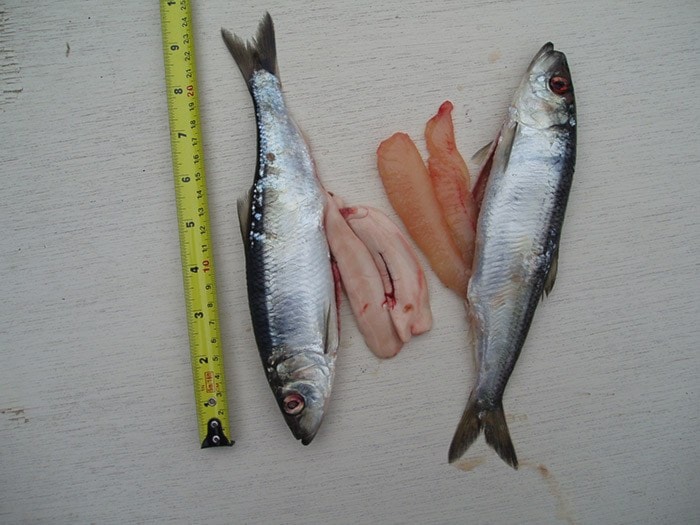When I try to wrap my head around the profound implications of the Pacific herring spawn in our local waters I have difficulty finding words to describe the magnitude of this huge gift from nature.
It is not my purpose to be critical of the harvest of the roe from the spawning fish, but I do suggest that the continued narrow use of such a profound resource is reflective of a society that has lost touch with the importance of these fish as food for people on a planet that is increasingly being challenged to feed everybody.
Pictured with the column are two mature herring. The fish on the left is a male, which is used for fertilizer, animal and fish meal but not used as people food; the fish on the right is a female and the exposed roe you can see from the body cavity is all that is used as food from it – the rest goes to the same use as the discarded males. The cured roe sells primarily in Japan at similar prices we pay for caviar in the sturgeon fishery
The 2014 Strait of Georgia roe herring fishery and spawning events have been happening in local waters off Tree Island and adjacent waters of Point Holmes and up the shoreline to at least Seal Bay for the past few days. I am told there are other locations in Lambert Channel and the south coast of Hornby Island.
Regardless of the number of spawning events, it is a gigantic life-renewing event for the herring and a survival event for the many animals, fish and birds that depend on this significant fish migration to replenish their fat and nutrition reserves depleted over the winter. It also helps the predatory species get in good health for their respective breeding cycles.
On two occasions I watched the fishery in progress from the shore. A sky full of circling eagles, huge numbers of other sea birds, large pods of Stellar and California sea lions and the controlled movement of seine and gillnet boats make for a futuristic scene of managed chaos we associate with some far-out movie scenes.
When looking at the sea lions in the water it is easy to underestimate the size of these large predators. The average mature Stellar sea lion male weighs in at close to a ton (2,000 pounds), and the females weigh up to 800 pounds. California sea lions are smaller at 500 to 600 pounds for males and females at 200 pounds.
Add to this mix hundreds of harbour seals that weigh in at approximately 200 pounds for adults you have a huge predator stock of mammals that are impacting the herring at many levels. Add to the mix the whales, salmon and other predator species it is a feast where the whole community of natures turns up.
The last time I walked the beach to watch the event you had to be impressed by the win rows of herring eggs that had washed in on the high tide. I took pictures of one concentration of spawn that was about 30-feet wide, at least a foot thick in many places and it stretched down the beach for hundreds of yards. At places it was just a few feet wide, but at others it was as I described it.
I am told that some of this roe that goes back out on the tide will hatch as long as it stays cool and wet. During the act of spawning and fertilization of the eggs, the sea turns white from the profusion of male sperms in the water. To witness the superabundance of eggs on the tide lines gives another dimension to this miraculous spawning event that is part of the rhythms of nature in Area 14 waters.
As this column comes out we are at the beginning of spring break for our schools. I suggest a great family venture to view some of the elements of this migration of natural life would be an extended trip along our local beaches.
I recommend starting your journey as far north as Miracle Beach Park and travelling south to at least Parksville. It could take a couple of days to travel the area covered by the spawn. Take cameras, binoculars, sunscreen and warm clothes.
Ralph Shaw is a master fly fisherman who was awarded the Order of Canada in 1984 for his conservation efforts. In 20 years of writing a column in the Comox Valley Record it has won several awards.
